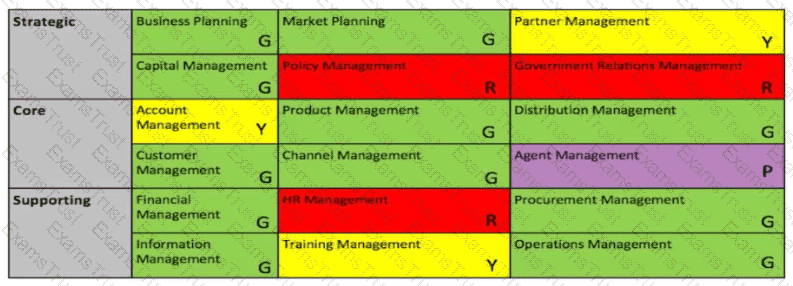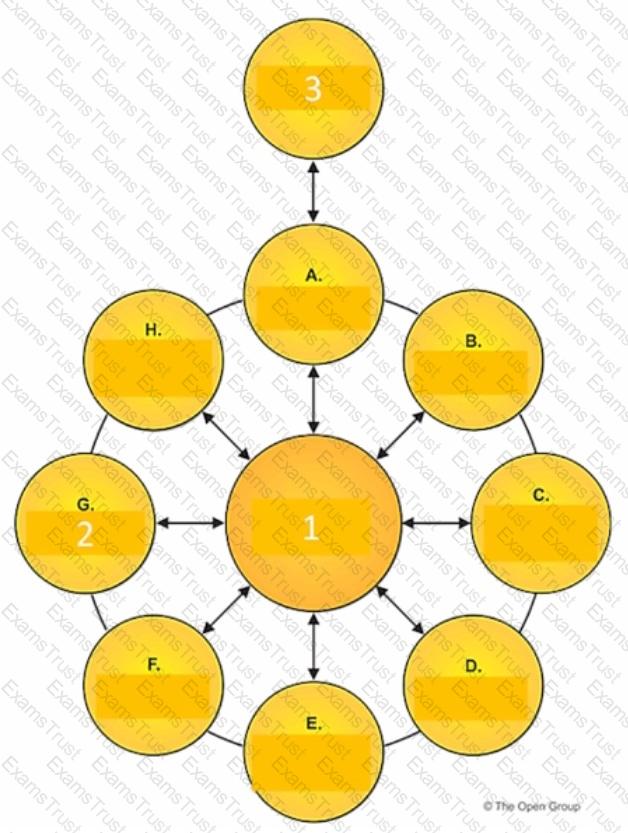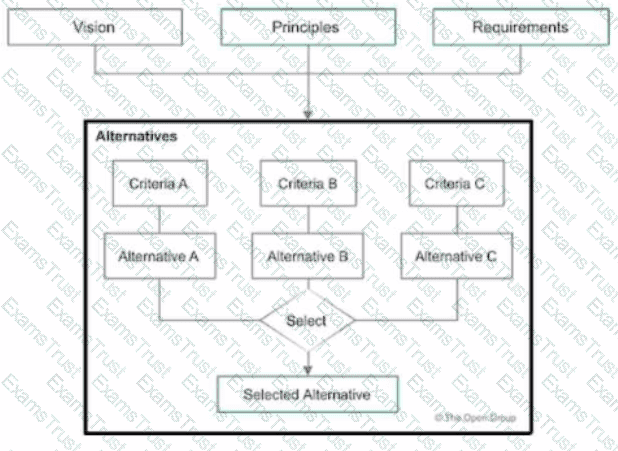Consider the following business capability map. where cells of a model are given different colors to represent desired maturity levels (Green (G) = level achieved, yellow (Y) = one level away, red (R) =two or more levels away, purple (P) = missing capability):

Which of the following best describes what this shows?
Consider the following business capability map. where cells of a model are given different colors to represent maturity levels (note the letters G, R. Y. P also denote the colors used = Green, Red. Yellow and Purple):

Which of the following best describes this technique?
Which of the following best describes the purpose of a Compliance Assessment?
Which of the following are used for structuring a business capability map?
Exhibit.

Consider the diagram of an architecture development cycle.
Select the correct phase names corresponding to the labels 1, 2 and 3?
In what TOGAF ADM phase is the organization map linked built out with the detail and relationships to overviews in order to understand the needs of the organization?
Consider the following:
You need to analyze a new value stream within the scope of a project.
Which of the following would you use?
Consider the following statement:
When considering agile development, Architecture to Support Project will identify what products the Enterprise needs, the boundary of the products, and the constraints that the product owner has.
What else does it help to define for the Enterprise?
Question: Which ADM Phases match the following purpose descriptions?

In business capability mapping, when you have documented all of the business capabilities, what should you do next?
Consider the diagram of an architecture development cycle.
Which description matches the phase of the ADM labeled as item 1?
Which of the following best describes the relationship between business models and business architecture?
Consider the following ADM phases objectives.

Which phase does each objective match?
Consider the following:
In Phase A a business capability map and a core set of value streams were created while developing the Architecture Vision.
Why would such Architecture Descriptions need to be updated in Phase B?
Which of the following can be used to help define information concepts in an information map?
Which approach to modeling business value is designed to create and end-to-end perspective of value from the customer's perspective?
In the ADM, what is the name for a document deliverable that has completed a review and is approved?
Which of the following best describes a business model?
Which of the following is a difference between an organization map and an organization chart?
Consider the following graphic illustrating a method supporting the TOGAF ADM.
What does the method help identify?
Consider the following graphic from the TOGAF Standard:

Why is this method used?
Which of the following is a benefit of information mapping?
Which of the following describes the concept of an Enterprise Architecture Capability?
Which of the following describes how business models are used within the TOGAF standard?
What process turns a set of business capabilities into a structure that communicates the right amount of detail to different stakeholder groups?
Which of the following is guidance for creating value streams?
In the diagram, what are the items labelled A, B, and C?
Consider the following representation of a business model:
Which of the following business models is this an example of?
In which phase of the ADM cycle do building blocks become Implementation-specific?
Which statement best describes iteration and the ADM?
Which of the following Business Architecture concepts should the architect examine and search for when developing the Architecture Vision?
Consider the following statements;
1. A whole corporation or a division of a corporation
2. A government agency or a single government department
3. Partnerships and alliances of businesses working together, such as a consortium or supply chain
What are those examples of according to the TOGAF Standard?
In which part of a business scenario are business capabilities and value streams modelled?
Consider the following statement.
Projects may cycle between ADM phases, in planned cycles covering multiple phases.
What does it illustrate?
Complete the sentence. A business model is a description of the rationale for how an organization creates, delivers, and captures
Complete the following sentence:
Presenting different ____ and ____ to stakeholders helps architects to extract hidden agendas, principles, and requirements that could impact the final Target Architecture.
Complete the sentence. The "Name" part of the recommended TOGAF template for Architecture Principles should________________________
Complete the sentence A business capability is_________________________________.